Influence of the Straining Path during Cold Drawing on the Hydrogen Embrittlement of Prestressing Steel Wires
Abstract
1. Introduction
2. Materials and Methods
Numerical Modeling of the Wire-Drawing Process
3. Results
3.1. Residual Stress and Strain States
3.2. Hydrogen Distributions
4. Discussion
4.1. Residual Stress and Strain States
4.2. Hydrogen Distributions
5. Conclusions
Author Contributions
Funding
Institutional Review Board Statement
Informed Consent Statement
Data Availability Statement
Conflicts of Interest
References
- Toribio, J.; Ayaso, F.J.; Gonzalez, B.; Matos, J.C.; Vergara, D.; Lorenzo, M. Tensile fracture behaviour of progressively-drawn pearlitic steels. Metals 2016, 6, 114. [Google Scholar] [CrossRef]
- Överstam, H. The influence of bearing geometry on the residual stress state in cold drawn wire by the FEM. J. Mater. Process. Technol. 2004, 171, 446–450. [Google Scholar] [CrossRef]
- Toribio, J.; Kharin, V.; Lorenzo, M.; Vergara, D. Role of drawing-induced residual stresses and strains in the hydrogen embrittlement susceptibility of prestressing steels. Corros. Sci. 2011, 53, 3346–3355. [Google Scholar] [CrossRef]
- Ma, A.; Zhang, Y.; Dong, L.; Yan, H.; Fang, F.; Li, Z. Damage and fracture analyses of wire with off-center inclusion on multi-pass drawing under different back tensions. Eng. Fail. Anal. 2022, 139, 106512. [Google Scholar] [CrossRef]
- Toribio, J.; Lorenzo, M. On the use of multi-step dies for improving the performance against hydrogen embrittlement of cold drawn prestressing steel wires. Materials 2022, 15, 9085. [Google Scholar] [CrossRef]
- Wang, J.-H.; Lo, Y.-L.; Wang, H.-Y.; Tran, H.-C. Multi-objective optimization framework for five-pass wire-drawing process. Inter. J. Adv. Manuf. Technol. 2020, 107, 3049–3063. [Google Scholar] [CrossRef]
- Radionova, L.V.; Gromov, D.V.; Svistun, A.S.; Lisovskiy, R.A.; Faizov, S.R.; Glebov, L.A.; Zaramenskikh, S.E.; Bykov, V.A.; Erdakov, I.N. Mathematical modeling of heating and strain aging of steel during high-speed wire drawing. Metals 2022, 12, 1472. [Google Scholar] [CrossRef]
- Ma, A.; Cheng, J.; Wei, D.; Li, Q.; Fang, F.; Li, Z. Experiments and numerical analyses on splitting fracture of wire under multi-pass drawing. Eng. Fail. Anal. 2022, 134, 106035. [Google Scholar] [CrossRef]
- Park, H.; Kim, S.H.; Lee, W.J.; Ha, J.-W.; Kim, S.-J.; Lee, H.-J. Effect of wire-drawing process conditions on secondary recrystallization behavior during annealing in high-purity copper wires. Met. Mater. Int. 2021, 17, 2220–2229. [Google Scholar] [CrossRef]
- Suresh, S. Fatigue of Materials, 2nd ed.; Cambridge University Press: Cambridge, UK, 1998. [Google Scholar]
- Toribio, J.; Matos, J.C.; González, B.; Escuadra, J. Influence of residual stress fields on the fatigue crack propagation in prestressing steel wires. Materials 2015, 8, 7589–7597. [Google Scholar] [CrossRef]
- Toribio, J.; Matos, J.C.; González, B.; Escuadra, J. Fatigue crack growth in round bars for rock anchorages: The role of residual stress. Procedia Struct. Integrity 2016, 2, 2734–2741. [Google Scholar] [CrossRef]
- Toribio, J.; Lorenzo, M.; Vergara, D.; Aguado, L. Residual stress redistribution induced by fatigue in cold-drawn prestressing steel wires. Constr. Build. Mater. 2016, 114, 317–322. [Google Scholar] [CrossRef]
- Toribio, J.; Lorenzo, M.; Vergara, D.; Aguado, L. The role of overloading on the reduction of residual stress by cyclic loading in cold-drawn prestressing steel wires. Appl. Sci. 2017, 7, 84. [Google Scholar] [CrossRef]
- Roh, Y.-H.; Cho, D.; Choi, H.-C.; Yang, Z.; Lee, Y. Process condition diagram predicting onset of microdefects and fracture in cold bar drawing. Metals 2021, 11, 479. [Google Scholar] [CrossRef]
- Lodini, A. The recent development of neutronic techniques for determination of residual stresses. Radiat. Phys. Chem. 2001, 67, 227–233. [Google Scholar] [CrossRef]
- Sato, S.; Wagatsuma, K.; Suzuki, S.; Kumagai, M.; Imafuku, M.; Tashiro, H.; Kajiwara, K.; Shobu, T. Relationship between dislocations and residual stresses in cold-drawn pearlitic steel analyzed by energy-dispersive X-ray diffraction. Mater. Charact. 2013, 82, 152–160. [Google Scholar] [CrossRef]
- Toribio, J.; Lorenzo, M.; Vergara, D.; Kharin, V. Influence of the die geometry on the hydrogen embrittlement susceptibility of cold drawn wires. Eng. Fail. Anal. 2014, 36, 215–225. [Google Scholar] [CrossRef]
- Toribio, J.; Lorenzo, M.; Vergara, D. On the use of varying die angle for improving the resistance to hydrogen embrittlement of cold drawn prestressing steel wires. Eng. Fail. Anal. 2015, 47, 273–282. [Google Scholar] [CrossRef]
- Santana Martinez, G.A.; Qian, W.L.; Kyo Kabayama, L.; Prisco, U. Effect of process parameters in copper-wire drawing. Metals 2020, 10, 105. [Google Scholar] [CrossRef]
- Suliga, M.; Wartacz, R.; Hawryluk, M.; Kostrzewa, J. The effect of drawing in conventional and hydrodynamic dies on structure and corrosion resistance of hot-dip galvanized zinc coatings on medium-carbon steel wire. Materials 2022, 15, 6728. [Google Scholar] [CrossRef]
- Hwang, J.-K. Impact of die radius in a streamlined die during wire drawing. Appl. Sci. 2021, 11, 3922. [Google Scholar] [CrossRef]
- Radionova, L.V.; Lisovskiy, R.A.; Svistun, A.S.; Gromov, D.V.; Erdakov, I.N. FEM simulation analysis of wire drawing process at different angles dies on straight-line drawing machines. In Proceedings of the 8th International Conference on Industrial Engineering, ICIE 2022, Braga, Portugal, 28–30 June 2022; Lecture Notes in Mechanical Engineering. Radionov, A.A., Gasiyarov, V.R., Eds.; Springer: Cham, Switzerland, 2023; Volume 1, pp. 769–778. [Google Scholar]
- Stolyarov, A.; Polyakova, M.; Atangulova, G.; Alexandrov, S. Effect of die angle and frictional conditions on fine grain layer generation in multipass drawing of high carbon steel wire. Metals 2020, 10, 1462. [Google Scholar] [CrossRef]
- Tzou, G.-Y.; Chai, U.-C.; Hsu, C.-M.; Hsu, H.-Y. FEM simulation analysis of wire rod drawing process using the rotating die under Coulomb friction. MATEC Web Conf. 2017, 123, 00033. [Google Scholar] [CrossRef]
- Baumann, M.; Selbmann, R.; Milbrandt, M.; Kräusel, V.; Bergmann, M. Adjusting the residual stress state in wire drawing products via in-process modification of tool geometries. Materials 2021, 14, 2157. [Google Scholar] [CrossRef] [PubMed]
- Kim, J.-H.; Baek, C.-H.; Lee, S.-K.; Kang, J.-H.; Park, J.-H.; Ko, D.-C. Effect of a multiple reduction die on the residual stress of drawn materials. Materials 2021, 14, 1358. [Google Scholar] [CrossRef] [PubMed]
- Lin, H.-S.; Hsu, Y.-C.; Keh, C.-C. Inhomogeneous deformation and residual stress in skin-pass axisymmetric drawing. J. Mater. Process. Technol. 2008, 201, 128–132. [Google Scholar] [CrossRef]
- Toribio, J.; Lorenzo, M. Reduction of residual stresses in cold drawn pearlitic steel by a soft secondary wire diameter reduction. Metals 2023, 13, 433. [Google Scholar] [CrossRef]
- Toribio, J.; Elices, M. Influence of residual stresses on hydrogen embrittlement susceptibility of prestressing steels. Int. J. Solids Struct. 1991, 28, 791–803. [Google Scholar] [CrossRef]
- Lynch, S.P. Failures of structures and components by environmentally assisted cracking. Eng. Fail. Anal. 1994, 1, 77–90. [Google Scholar] [CrossRef]
- Mallick, A.; Das, S.; Mathur, J.; Bhattacharyya, T.; Dey, A. Internal reversible hydrogen embrittlement leads to engineering failure of cold drawn wire. Case Studies Eng. Fail. Anal. 2013, 1, 139–143. [Google Scholar] [CrossRef]
- Nakamura, S.-I.; Suzumura, K. Hydrogen embrittlement and corrosion fatigue of corroded bridge wires. J. Constr. Steel Res. 2009, 65, 269–277. [Google Scholar] [CrossRef]
- Vehovar, L.; Kuhar, V.; Vehovar, A. Hydrogen-assisted stress-corrosion of prestressing wires in a motorway viaduct. Eng. Fail. Anal. 1998, 5, 21–27. [Google Scholar] [CrossRef]
- Perrin, M.; Gaillet, L.; Tessier, C.; Idrissi, H. Hydrogen embrittlement of prestressing cables. Corros. Sci. 2010, 52, 1915–1926. [Google Scholar] [CrossRef]
- Toribio, J.; Kharin, V.; Vergara, D.; Lorenzo, M. Two-dimensional numerical modelling of hydrogen diffusion in metals assisted by both stress and strain. Adv. Mater. Res. 2010, 138, 117–126. [Google Scholar] [CrossRef]
- Panasyuk, V.V.; Ivanyts’kyi, Y.-L.; Hembara, O.V.; Boiko, V.M. Influence of the stress-strain state on the distribution of hydrogen concentration in the process zone. Mater. Sci. 2014, 50, 315–323. [Google Scholar] [CrossRef]
- Thompson, A.W.; Chesnutt, J.C. Identification of a fracture mode: The tearing topography surface. Metall. Trans. A 1982, 10, 379–405. [Google Scholar] [CrossRef]
- Costa, J.E.; Thompson, A.W. Hydrogen cracking in nominally pearlitic 1045 steel. Metall. Trans. A 1982, 13, 1315–1318. [Google Scholar] [CrossRef]
- Toribio, J.; Lancha, A.M.; Elices, M. Characteristics of the new tearing topography surface. Scr. Metall. Mater. 1991, 25, 2239–2244. [Google Scholar] [CrossRef]
- Toribio, J.; Lancha, A.M.; Elices, M. The tearing topography surface as the zone associated with hydrogen embrittlement processes in pearlitic steel. Metall. Trans. A 1992, 23, 1573–1584. [Google Scholar] [CrossRef]
- Enos, D.G.; Williams, A.J.; Scully, J.R. Long-term effects of cathodic protection of prestressed concrete structures: Hydrogen embrittlement of prestressing steel. Corrosion 1997, 53, 891–908. [Google Scholar] [CrossRef]
- Toribio, J.; Kharin, V. A hydrogen diffusion model for applications in fusion nuclear technology. Fusion Eng. Des. 2000, 51–52, 213–218. [Google Scholar] [CrossRef]
- Toribio, J.; Kharin, V. A generalised model of hydrogen diffusion in metals with multiple trap types. Philos. Mag. 2015, 95, 3429–3451. [Google Scholar] [CrossRef]
- Toribio, J.; Kharin, V. Hydrogen transport to fracture sites in metals and alloys: Multiphysics modelling. Struct. Integrity Proc. 2017, 5, 1291–1298. [Google Scholar] [CrossRef]
- Zienkiewicz, O.C.; Taylor, R.L. The Finite Element Method, 4th ed.; McGraw-Hill: London, UK, 1991; Volume 2. [Google Scholar]
- Hirth, J.P. Effects of hydrogen on the properties of iron and steel. Metall. Trans. A 1980, 11, 861–890. [Google Scholar] [CrossRef]
- Lillard, R.S.; Enos, D.G.; Scully, J.R. Calcium hydroxide as a promoter of hydrogen absorption in 99.5% Fe and a fully pearlitic 0.8% C steel during electrochemical reduction of water. Corrosion 2000, 56, 1119–1132. [Google Scholar] [CrossRef]
- Toribio, J.; Kharin, V. The effect of history on hydrogen assisted cracking: 1. Coupling of hydrogenation and crack growth. Int. J. Fract. 1997, 88, 233–245. [Google Scholar] [CrossRef]
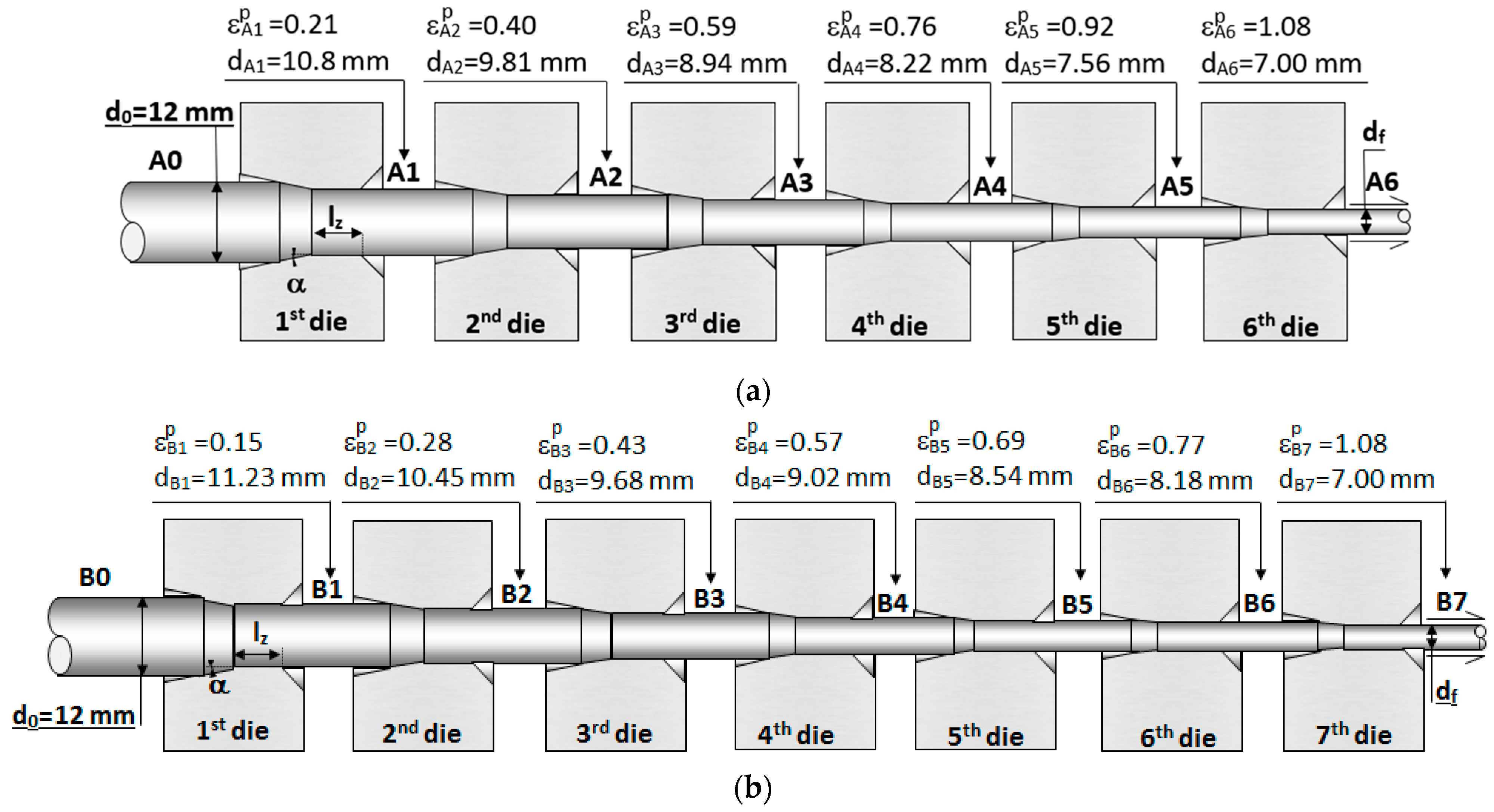
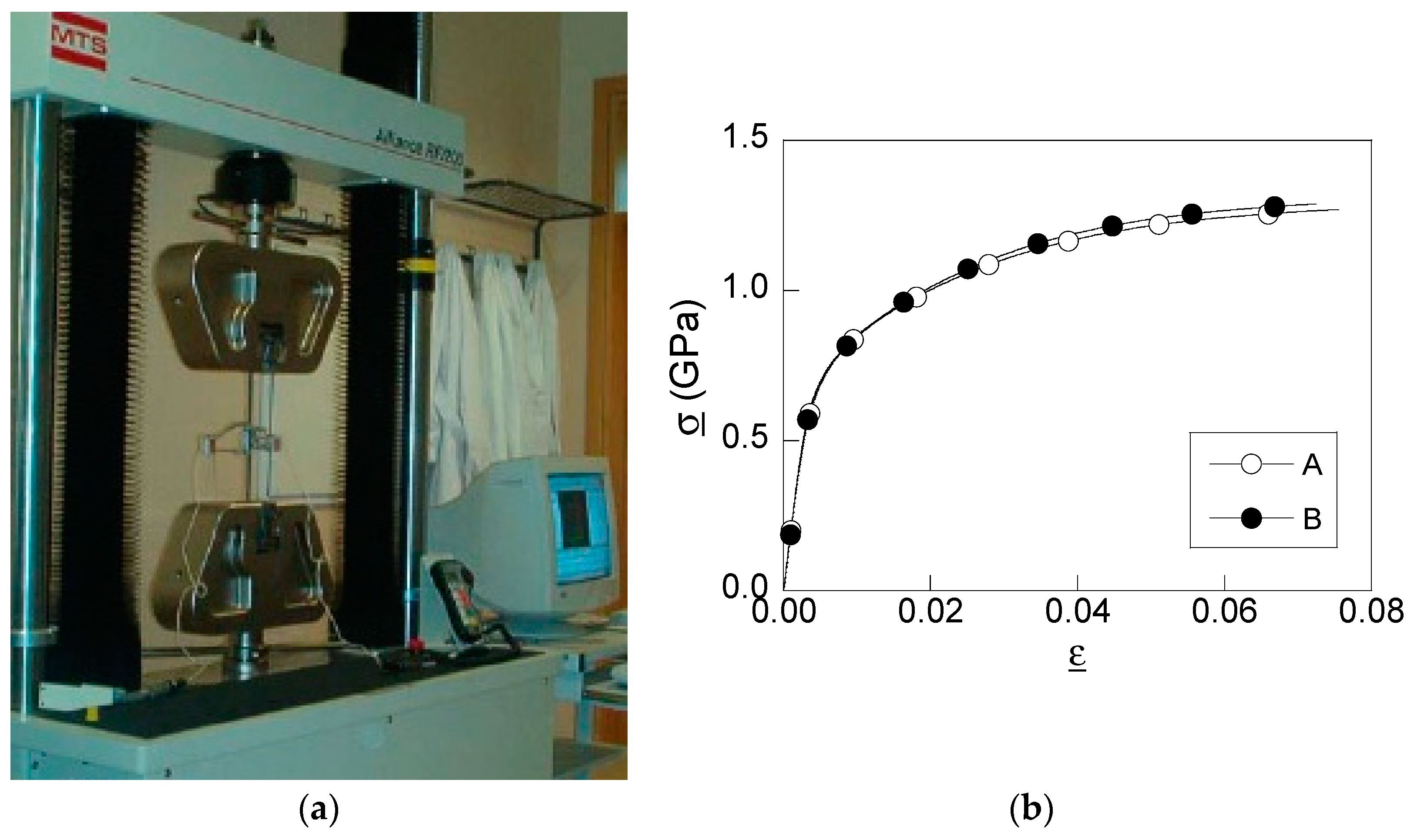

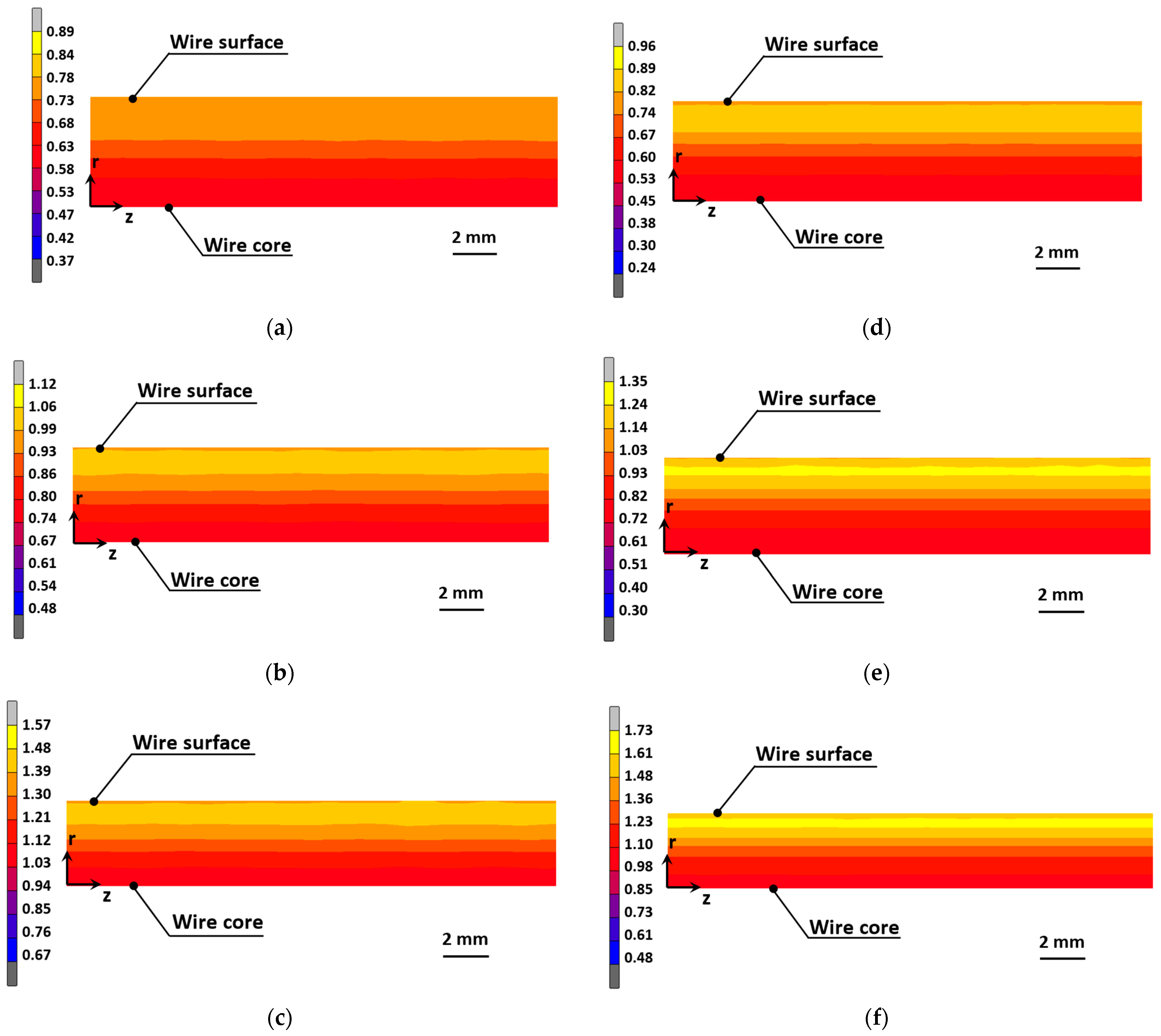
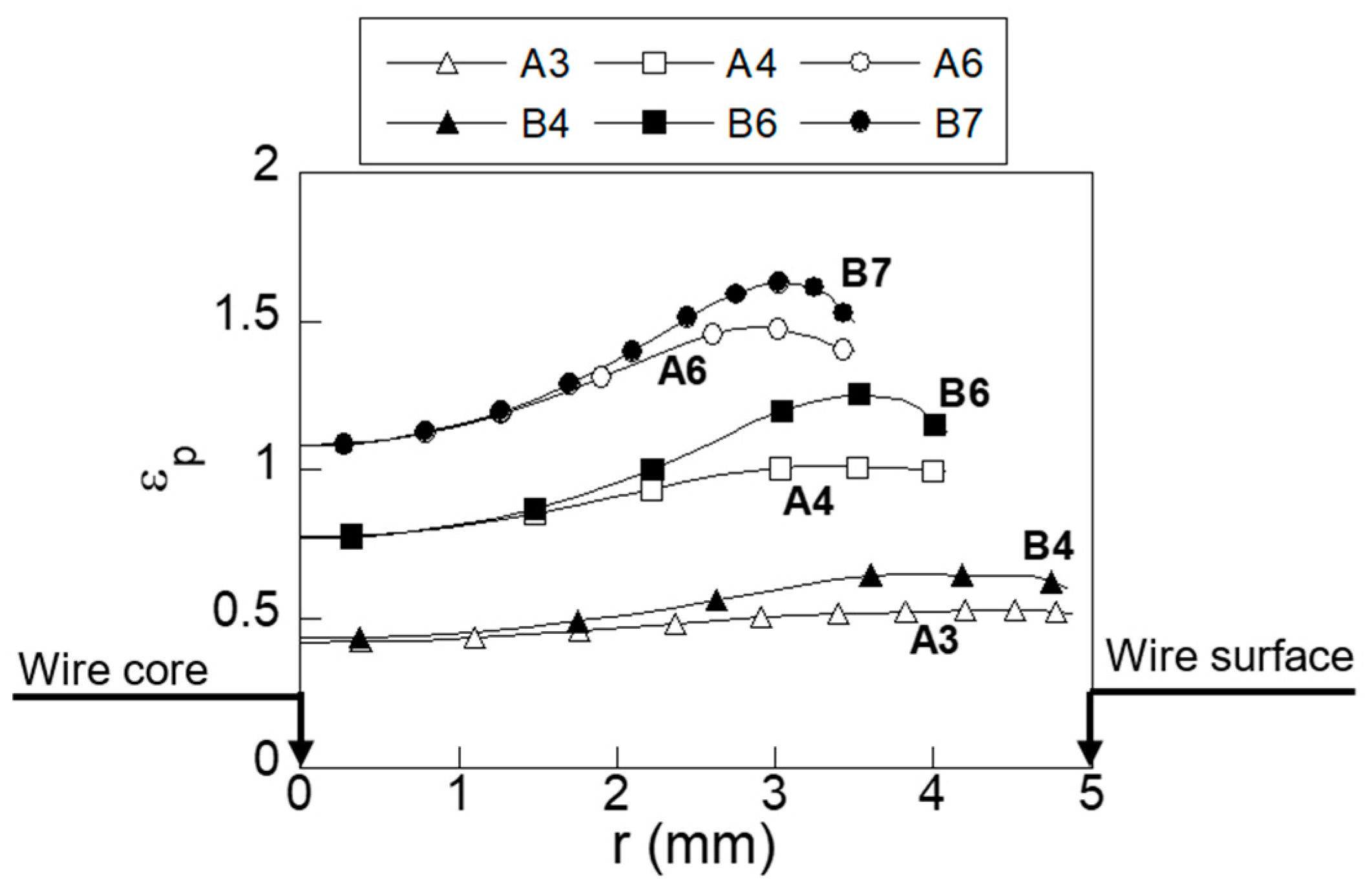
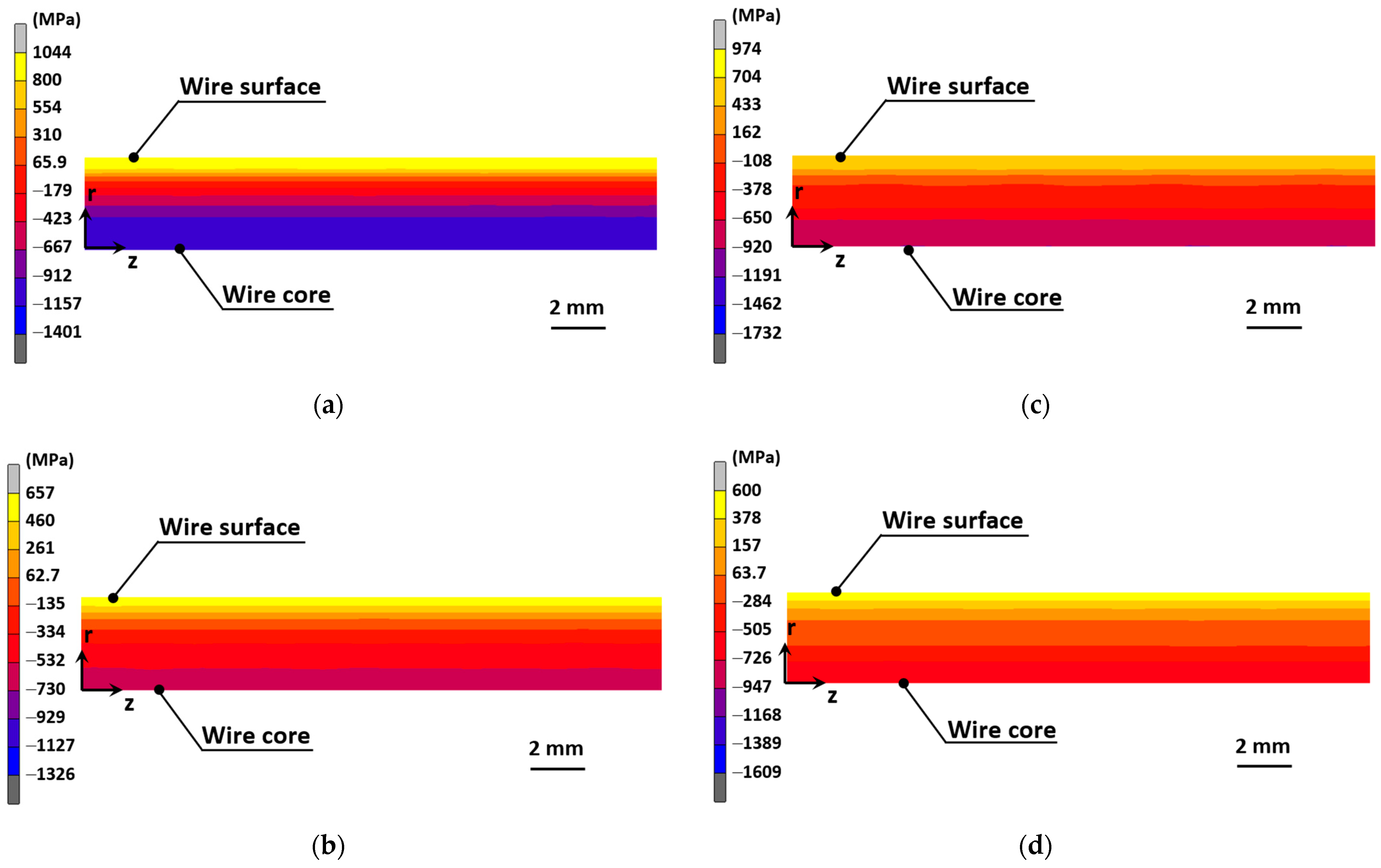
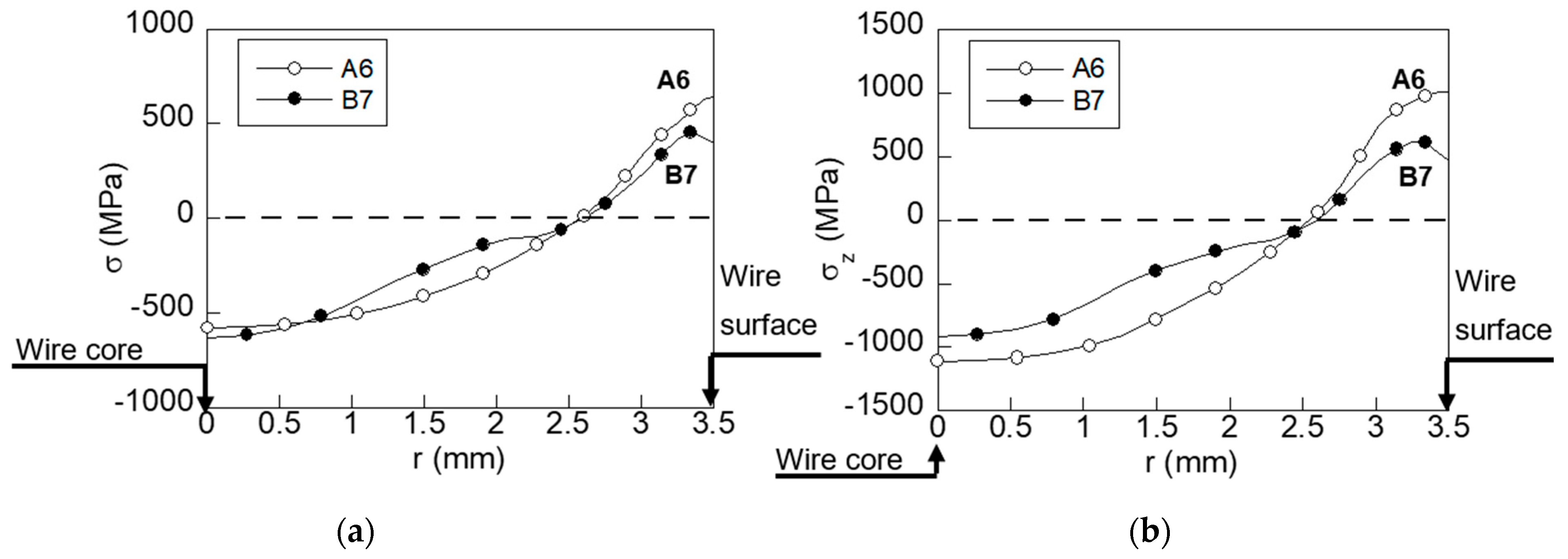
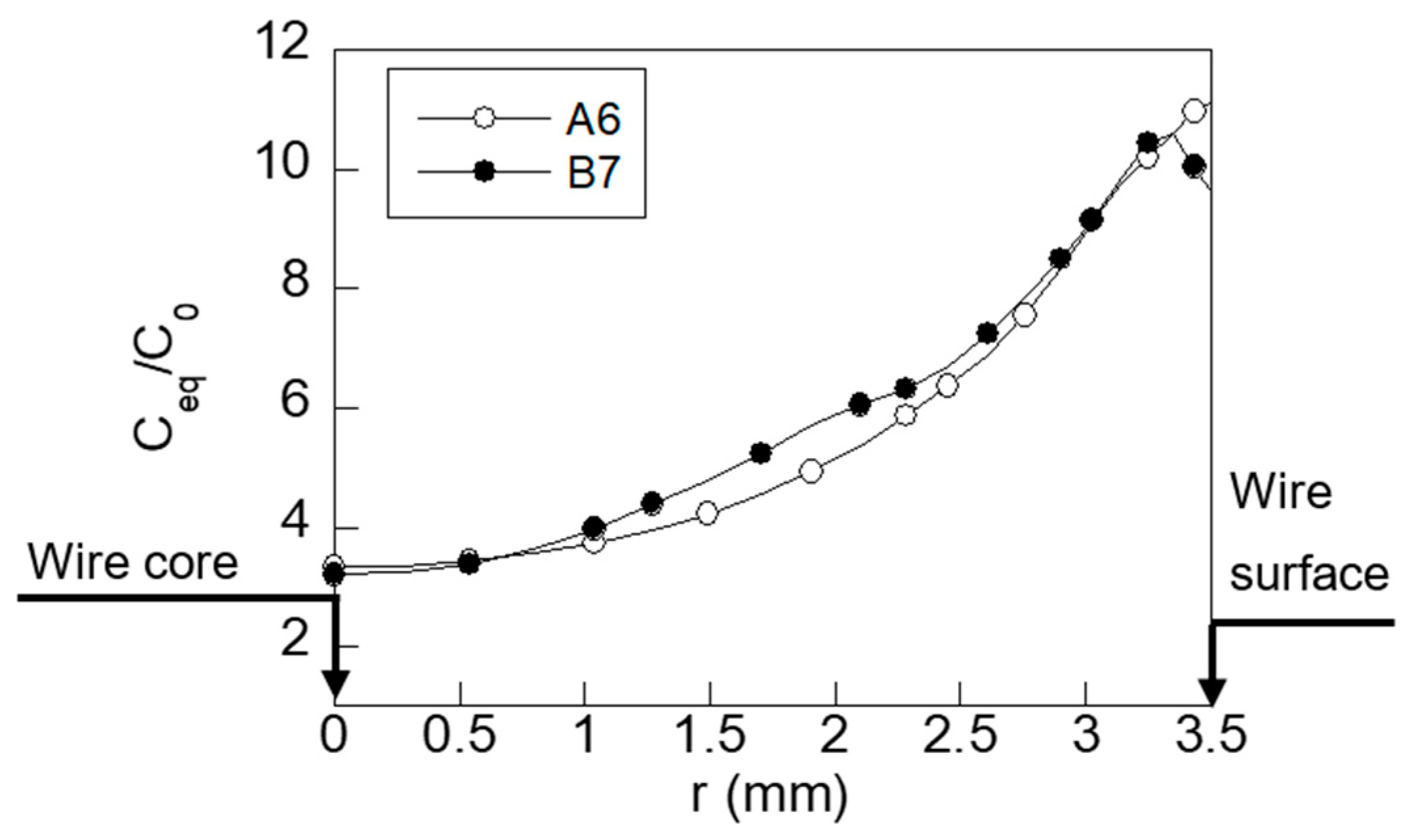
| % C | % Mn | % Cr | % Si | % V | % P | % S | % Al | |
|---|---|---|---|---|---|---|---|---|
| Steel A | 0.800 | 0.690 | 0.265 | 0.230 | 0.060 | 0.012 | 0.009 | 0.004 |
| Steel B | 0.789 | 0.698 | 0.271 | 0.226 | 0.078 | 0.011 | 0.005 | 0.003 |
| Wire-Drawing A | Wire-Drawing B | |||
|---|---|---|---|---|
| E (GPa) | σY (MPa) | E (GPa) | σY (MPa) | |
| Initial | 194 | 720 | 202 | 720 |
| Step 1 | 201 | 1110 | 204 | 840 |
| Step 2 | 187 | 1120 | 204 | 880 |
| Step 3 | 190 | 1118 | 203 | 950 |
| Step 4 | 190 | 1260 | 203 | 1010 |
| Step 5 | 295 | 1330 | 201 | 1090 |
| Step 6 | 207 | 1570 | 201 | 1120 |
| Step 7 | - | - | 205 | 1580 |
Disclaimer/Publisher’s Note: The statements, opinions and data contained in all publications are solely those of the individual author(s) and contributor(s) and not of MDPI and/or the editor(s). MDPI and/or the editor(s) disclaim responsibility for any injury to people or property resulting from any ideas, methods, instructions or products referred to in the content. |
© 2023 by the authors. Licensee MDPI, Basel, Switzerland. This article is an open access article distributed under the terms and conditions of the Creative Commons Attribution (CC BY) license (https://creativecommons.org/licenses/by/4.0/).
Share and Cite
Toribio, J.; Lorenzo, M. Influence of the Straining Path during Cold Drawing on the Hydrogen Embrittlement of Prestressing Steel Wires. Metals 2023, 13, 1321. https://doi.org/10.3390/met13071321
Toribio J, Lorenzo M. Influence of the Straining Path during Cold Drawing on the Hydrogen Embrittlement of Prestressing Steel Wires. Metals. 2023; 13(7):1321. https://doi.org/10.3390/met13071321
Chicago/Turabian StyleToribio, Jesús, and Miguel Lorenzo. 2023. "Influence of the Straining Path during Cold Drawing on the Hydrogen Embrittlement of Prestressing Steel Wires" Metals 13, no. 7: 1321. https://doi.org/10.3390/met13071321
APA StyleToribio, J., & Lorenzo, M. (2023). Influence of the Straining Path during Cold Drawing on the Hydrogen Embrittlement of Prestressing Steel Wires. Metals, 13(7), 1321. https://doi.org/10.3390/met13071321






